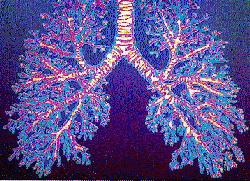 |
SPIROMETRY QUESTIONS & ANSWERS |
©Priory Lodge Education Limited, 1997
 |
SPIROMETRY QUESTIONS & ANSWERS |
Q. What does spirometry measure?
A. Spirometry provides an objective measurement of lung function.
It will measure:
a) Expiratory Vital Capacity (EVC): The maximum volume of gas which can be expired from the lungs during a relaxed expiration from a position of full inspiration.b) Inspiratory Vital Capacity (IVC): The maximum volume of gas which can be inspired into the lungs during a relaxed inspiration from a position of full expiration. The expiratory phase is the one more commonly used to measure obstruction and restriction within the lungs. This can be done in two ways:
- 1. Static test - performed without regard to time e.g. Vital Capacity (VC)
- 2. Dynamic test - performed at forcible and maximum effort against time. e.g. FEV, (Forced expiratory volume in the first second from a maximum inspiration)
Q. What do the different parameters within spirometry testing mean?
| A. Static tests: | B. Dynamic tests. |
| Vital Capacity (VC): Is
the change in volume of gas in the lungs
|
Forced Expiratory Volume in first second (FEV1): Is the volume of air expelled in the first second of a forced expiration starting from full inspiration. FEV1%: This is the FEV1 expressed as a percentage of the total volume. It is sometimes called the FEV1 Ratio or theFEV1/ VC% when it is shown as a percentage of the VC volume, or the FEV1/FVC% when shown as a percentage of the FVC. This parameter has nothing to do with predicted values. (In normal lung function this should generally be over 75%, ie. the subject should get at least three quarters of their total air out in the first second). |
| Forced Vital
Capacity (FVC): The maximum volume of air in
litres that |
Peak Expiratory Flow Rate (PEFR): Is
the greatest flow |
| Forced Expiratory Flow Rate (FEFR 25% - 75%): This
is the average forced expiratory flow rate at the middle |
Q. How do you interpret spirometry readings?
A. Spirometry results may be used to classify a patient's lung
function into one of four different disease patterns or classifications
of ventilatory function; Normal, Obstructive, Restrictive and Combined.
| Normal Ventilatory Function: A
person with Normal Spirometry |
Obstructive Ventilatory Function: An
obstructive disorder refers to any disease |
| Restrictive Ventilatory Function: A
restrictive disorder is one that may affect the lung
tissue itself or the |
|
| Combined Ventilatory Function: A combined disorder is venffiatory disorder exhibiting the features of both an obstructive and restrictive deficit. Examples of this pattern include Cystic Fibrosis, which causes excess mucus production and damage to the lung tissue. |
|
Q. What standards/procedures are recommended when
taking spirometry readings?
A. It is recommended that the best of 3 FVC manoeuvres are
taken, the best 2 being within 5% of each other.
Q. Can FEV1 values be used to classify
Chronic Obstructive Pulmonary Disease (COPD)?
A. Yes. Generally the following FEV1 values (expressed as a percentage of predicted) may classify the severity of the COPD;
| 60% - 79% predicted: MILD COPD |
| 40% - 59% predicted: MODERATE COPD |
| Less than 40% predicted: SEVERE COPD |
Q. What's the difference between spirometry measurement and peak flow reading?
A. Spirometry devices record the whole of the FVC manoeuvre
against time, allowing the dynamics of the resulting time/volume
curve to be examined.
Peak Expiratory Flow records the greatest flow that can be
sustained for 10 milliseconds on forced expiration starting from full
inflation of the lungs.
Q. Which measurement is more accurate/appropriate in patients with COPD; spirometry or peak flow?
A. Many doctors and nurses have become used to measuring serial
peak flow measurements as part of asthma care. PEF is a more
simple measure than FEV1 and repeat measurements can
be easily performed at home by the patient using a hand held peak
flow meter. As such, they might appear of immediate
value in COPD. However, there are important physiological differences
between COPD and asthma which limit the value of PEF in COPD. In
asthma there is a reasonably good correlation between PEF and FEV1
which allows the use of PEF as a surrogate for FEV1.
In COPD this relationship breaks down. Because the amount of
airway collapsibihty varies between COPD patients, the
relationship between PEF and FEV1 will also vary. PEF
can be misleadingly optimistic and therefore it may be severely
limited as a diagnostic tool.
In addition, PEF is not a sensitive measure for detecting the
small treatment changes typical of COPD.
Q. Where does peak flow fit in and what is its role?
A. Peak flow meters measure the rate at which a patient can
exhale. Serial peak flow measurements are therefore useful in the
management of asthma where there's good correlation between
PEF and FEV1 and where the importance of distinguishing
diurnal variability as a reliable defining characteristic in
asthma is well established.
PEF monitoring can be a useful tool when titrating treatment to
prevent an asthma attack.